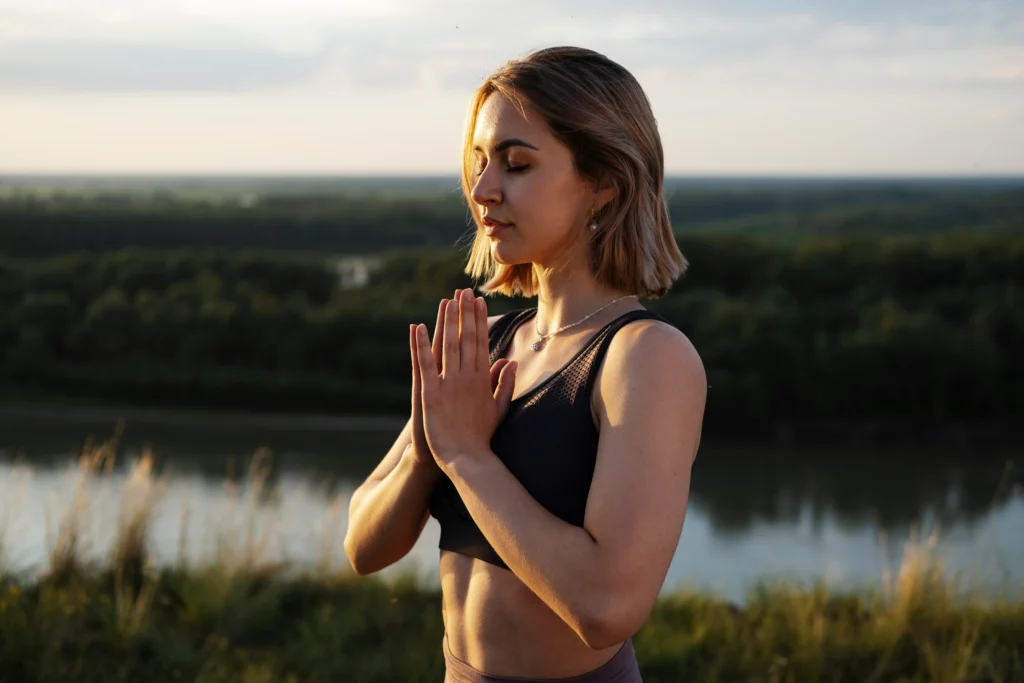Surya Namaskar, also known as the Sun Salutation pose, is a traditional yoga practice that originated in ancient India. ‘Surya’ means ‘sun’ and ‘Namaskar’ means ‘salutation’ or ‘greeting’. One complete Surya Namaskar is a sequence of 12 yoga poses, each coordinated with breath. It is more of a spiritual practice that stands for paying homage to the Sun Lord, who is considered a vital source of life and energy.
The practice of Surya Namaskar has been passed down through generations in India and has deep spiritual and philosophical roots. Each pose in the sequence represents a specific aspect of the sun, such as its warmth, light, and vitality. By performing Surya Namaskar, one attempts to awaken and harness these qualities within themselves.
Why Should We Do Surya Namaskar
There are numerous reasons why incorporating Surya Namaskar into your daily routine can be beneficial. Firstly, it is a complete body workout that engages all the major muscle groups, providing strength and flexibility to the entire body. The dynamic movements and stretches involved in Surya Namaskar helps to improve blood circulation, enhance metabolism, promote overall physical fitness and assist in weight loss.
In addition to its physical benefits, Surya Namaskar also has a profound impact on mental and emotional well-being. The synchronized breathing and focused awareness during the practice help to calm the mind, reduce stress, and improve concentration. It can also help in balancing the energy centers in the body, known as chakras, and promote a sense of inner harmony and balance.
Furthermore, Surya Namaskar is a great way to kickstart your day with positivity and gratitude. By offering salutations to the sun, you are acknowledging the life-giving energy and expressing gratitude for the blessings in your life.
How to do Surya Namaskar
To perform Surya Namaskar, start by standing at the front of your mat with your feet together and your hands at your heart center in a prayer pose (Pranamasana). Take a deep breath in and as you exhale, bring your hands down to your sides.
Inhale deeply and raise your arms overhead, stretching your whole body upwards (Hastauttanasana). As you exhale, bend forward from the hips and bring your hands down to the floor beside your feet (Hasta Padasana).
Inhale and step your right leg back into a lunge position, with your right knee on the floor and your hands on either side of your left foot (Ashwa Sanchalanasana). As you exhale, step your left leg back to come into a plank position, with your body in a straight line (Dandasana).
Lower your knees, chest, and chin to the floor, keeping your elbows close to your body (Ashtanga Namaskara). Inhale and slide forward into a cobra pose, lifting your chest off the floor while keeping your hips and legs on the ground (Bhujangasana).
Exhale and lift your hips up and back, coming into an inverted V shape with your body (Adho Mukha Svanasana). Hold this pose for a few breaths, then inhale and step your right foot forward between your hands (Ashwa Sanchalanasana).
Exhale and step your left foot forward to meet your right foot, coming into a forward bend with your hands reaching towards the ground (Hasta Padasana). Inhale and rise, stretching your arms overhead and arching your back (Hastauttanasana).
Finally, exhale and return to the starting position with your hands at your heart center in prayer pose (Pranamasana). This completes one round of Surya Namaskar. Repeat the sequence for the desired number of rounds, gradually increasing the pace and intensity as you become more comfortable.
Remember to synchronize your breath with the movements, inhaling during the upward movements and exhaling during the downward movements. Start with a few rounds and gradually increase the number as you build strength and flexibility.
Tips for Beginners and Advanced Practitioners of Surya Namaskar
If you are new to Surya Namaskar, it is important to start slow and gradually build up your practice. Begin with a few rounds and focus on getting the alignment and breathing technique right. As you become more comfortable, you can gradually increase the number of rounds and explore variations of the poses.

As with every form of exercise, it is important to listen to your body and practice within your limits. Do not push yourself too hard and avoid any movements or poses that cause pain or discomfort. It is always advisable to practice under the guidance of a qualified yoga teacher, especially if you have any pre-existing medical conditions or injuries.
For advanced practitioners, you can challenge yourself by increasing the pace and intensity of the practice. You can also explore advanced variations of the poses or incorporate props to deepen the practice. However, it is important to maintain proper alignment and listen to your body’s signals to prevent any injuries.
Regardless of your level of practice, it is important to approach Surya Namaskar with a sense of mindfulness and reverence. Remember to focus on your breath, stay present in the moment, and cultivate a deep connection with yourself and the practice. With regular and dedicated practice, you can unlock the full benefits of Surya Namaskar and experience its transformative power.


1 thought on “Exploring Surya Namaskar : The Sun Salutation Pose”